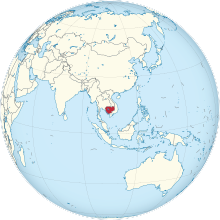Squatting in Cambodia

Land disputes and evictions are common across Cambodia. Squatters are known officially as the "urban poor" or "temporary residents".
Legality
History
20th century
After the
In 1989, the new State of Cambodia launched a sweeping land reform program, recognising 4.9 million claims for title between 1989 and 1993.[5] The United Nations Transitional Authority in Cambodia (UNTAC) oversaw reforms and also caused land prices to soar by inserting $2.8 billion into the local economy.[5]
21st century
Until the end of the 1990s, the Phnom Penh authorities did not recognise squatters and tended to evict squats. As of 2003, an estimated 25 per cent of the city's population were squatters.[2]: 5, 16 Land disputes and evictions are still common. The World Bank estimated that in Phnom Penh alone, 11,000 households had been evicted between 1998 and 2003.[6]
In 2005, soldiers shot dead six squatters in an eviction and the following year, soldiers and riot police were used to evict a thousand slum-dwellers in Phnom Penh.[7] Amnesty International stated in 2008 that 150,000 people were at risk of being forcibly displaced.[6]
As of 2014, there were estimated to be 300
In 2023, the
References
- ^ a b c Hap, Phalthy (2013). "Law Enforcement Towards Squatters in Cambodia". KLRI Journal of Law and Legislation.
- ^ a b Fallavier, Pierre (2003). "The case of Phnom Penh" (PDF). Urban Slums Reports. UCL. Retrieved 12 April 2021.
- ^ a b McPherson, Poppy (23 July 2014). "Inside the famous Phnom Penh cinema that has become a living nightmare". The Guardian. Retrieved 12 April 2021.
- ^ Hale, Erin (4 December 2015). "A Utopian, Futurist Housing Project in Cambodia Has Seen Better Days". Slate Magazine. Retrieved 12 April 2021.
- ^ S2CID 151319081.
- ^ a b Mydans, Seth (17 July 2008). "In Cambodia, progress for some means eviction for others". The New York Times. Retrieved 12 April 2021.
- ^ "Cambodian troops evict squatters". Business & Human Rights Resource Centre. 6 June 2006. Retrieved 12 April 2021.
- ^ a b Peck, Grant (14 November 2023). "UNESCO is criticized after Cambodia evicts thousands around World Heritage site Angkor Wat". AP News. Retrieved 27 April 2024.
- ^ "Amnesty accuses Cambodia over 'forced evictions' at Angkor Wat". France 24. 14 November 2023. Retrieved 27 April 2024.
- ^ Rising, David (4 March 2024). "Cambodia defends family relocations around the famous Angkor Wat temple complex". AP News. Retrieved 27 April 2024.

